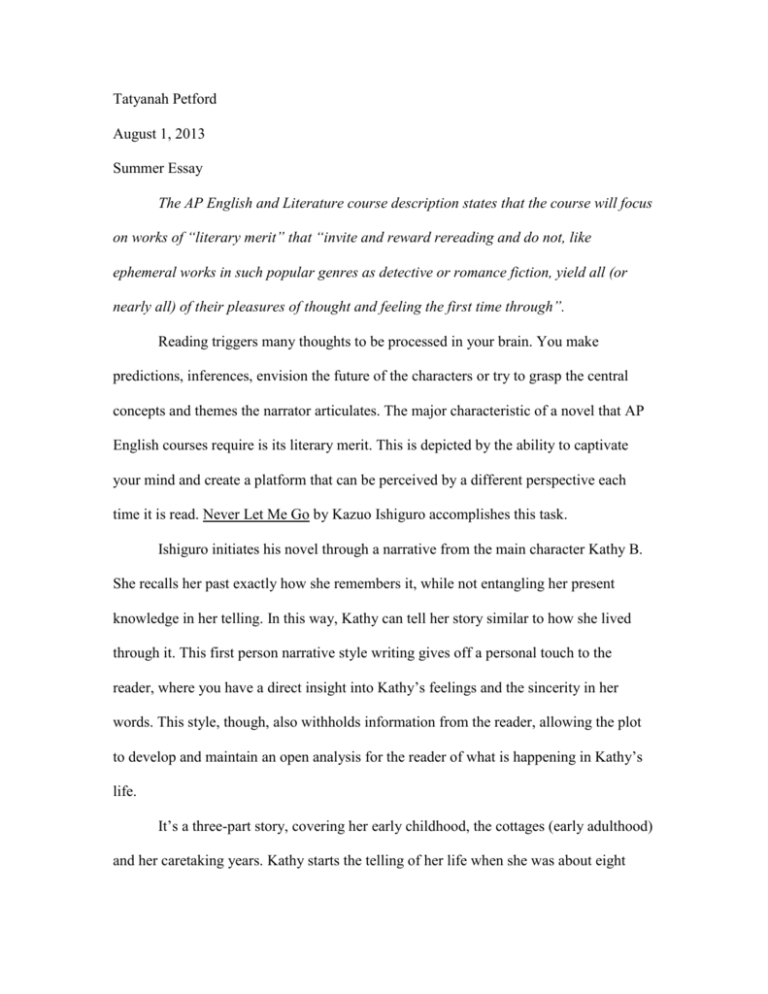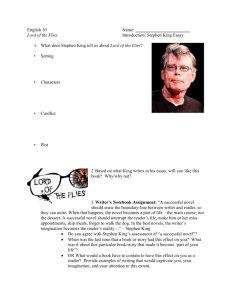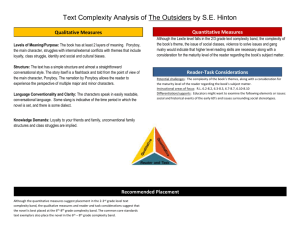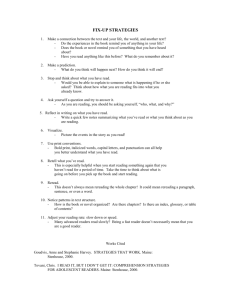Tatyanah Petford - AHS LIBRARY OF BABEL
advertisement

Tatyanah Petford August 1, 2013 Summer Essay The AP English and Literature course description states that the course will focus on works of “literary merit” that “invite and reward rereading and do not, like ephemeral works in such popular genres as detective or romance fiction, yield all (or nearly all) of their pleasures of thought and feeling the first time through”. Reading triggers many thoughts to be processed in your brain. You make predictions, inferences, envision the future of the characters or try to grasp the central concepts and themes the narrator articulates. The major characteristic of a novel that AP English courses require is its literary merit. This is depicted by the ability to captivate your mind and create a platform that can be perceived by a different perspective each time it is read. Never Let Me Go by Kazuo Ishiguro accomplishes this task. Ishiguro initiates his novel through a narrative from the main character Kathy B. She recalls her past exactly how she remembers it, while not entangling her present knowledge in her telling. In this way, Kathy can tell her story similar to how she lived through it. This first person narrative style writing gives off a personal touch to the reader, where you have a direct insight into Kathy’s feelings and the sincerity in her words. This style, though, also withholds information from the reader, allowing the plot to develop and maintain an open analysis for the reader of what is happening in Kathy’s life. It’s a three-part story, covering her early childhood, the cottages (early adulthood) and her caretaking years. Kathy starts the telling of her life when she was about eight years old. This is where she begins to realize how she and everyone at Hailsham are different from the outside world. “The first time you glimpse at yourself through the eyes of a person like that, it’s a cold moment. It’s like walking past a mirror you’ve walked past every day of your life, and suddenly it shows you something else, something troubling and strange,” (pg 36). While this part of her life is told, the reader gets a personal glimpse into what Kathy underwent at the privileged school. She and the others are sheltered from the outside cruelty, while not knowing exactly what they are being protected from. A central idea the narrator tries to maintain through her storytelling is how the students were raised, being told but not really told. This is one of the many “pleasures of thought” that arises in the novel. These pleasures provide the reader a transition from one perspective to the other. Looking through Miss Lucy’s perspective, it is unfair to the students that they don’t understand the meaning of their existence; while on the other hand, in Miss Emily’s eyes, the students are given a childhood with the lack of information. A great example of this is after Miss Emily tells Kathy that the gallery was to show that the students had souls. “Why did you have to prove a thing like that, Miss Emily? Did someone think we didn’t have souls?” (260). This proves how little the students knew of their existence in reference to people outside of their home. This novel sheds light on what makes us human, and the prejudice that arises from medical controversies of donations and cures. The school that Kathy and the other clones attend provide a childhood to the students. The reference to them as only students and not clones is itself a conscious decision in preserving their innocence. Miss Emily, the head guardian, struggled to get the school to the point it is at now. Hailsham is the only place the students can be untouched from the outside world. They are oblivious and ignorant of what everyone outside really thinks of them. They are even ignorant of what their guardians think. Later when Kathy and Tommy look for Madame, Miss Emily reveals her true thoughts of the students. “Is she afraid of you? We’re all afraid of you. I myself had to fight back any dread of you all almost every day I was at Hailsham. There were times I’d look down at you all from my study window and I’d feel such revulsion,” (269). Even Madame refers to them as less than human. “Poor creatures. I wish I could help you. But now you’re by yourselves,” (272). These views are more universal in the novel than the clones know and this was done purposefully. Though this novel is fiction, the difficulties that arose in the character’s lives are realistic and possible. This characteristic provokes the reader to emerge themselves entirely in the novel’s plot. If the text is relatable to real life, or to the reader’s life, then the reader can be connected to the text on a new level. This level provides variability of perspectives because the meaning the reader retrieves from each reading can change. As the reader’s thoughts and perspective changes about everything in their own life, so does the meaning they get from the novel. In simplest words, the text is open to interpretation. The Bonesetter’s Daughter by Amy Tan has also accomplished this task. Tan’s novel reflects the diverse ideas and relations of family, with an emphasis on motherdaughter relationships. The narrator for the majority of the novel speaks in third person while telling Ruth’s story. This style allows the reader to know more than just what is happening to the main character. The minor section is told in first person narrative from Luling’s, Ruth’s mother, perspective on her childhood. These styles serve the purpose of telling Ruth’s overall story, of how her life became better. In a sense she broke the curse on her family, where no one would ever be happy, by the end of the novel. Ruth tells stories of her childhood and present day life. Until she reads her mother’s life story she can’t understand her early years. Ruth realizes this once she reads her mother’s story and understands the significance of her mother’s actions when she was young, like why she deeply believed in curses and always wanted to contact her dead nursemaid. These truths, once told, reveal many parallels that are set between Ruth and her mother, even with her grandmother. One being how all three of them seriously contemplated suicide. This connection between the three bonds them while also complicating their relationships. Ruth’s mother always threatened her with killing herself which “never ceased to grab her by the throat” (Tan 111). It deeply impacted Ruth just as it deeply impacted Luling, whose mother actually did commit suicide. Tan is able to make The Bonesetter’s Daughter a work of literary merit because it allows the reader to read the same words but through different eyes. In one perspective, Luling is damaged by the childhood she lived- not knowing her real mother until it was too late- while on other hand, Luling is stronger because of it. The established characters allow the reader to look at one event at the beginning, like Ruth writing on the sand board was absurd through Ruth’s eyes, then once you see the whole picture you see the reason behind it, that is how Luling used to talk to Precious Auntie (her mother). Family experiences impact each individual’s life. In Tan’s novel, the complexities of the family history provide a basis for the reader to reflect on their life experiences and interpret what it means to them and also to the characters. What gives a novel literary merit is the characters and how the story is told. The characters provide a different doorway the reader can open to see the novel in a new light. How the story is told gives the platform for which the doorways exist. Literary merit is not based on the high ratings of a book that ends up on the bestseller’s list, but from the message you get each time the reader examines the book. The complexity of the message does not matter, but the quality of what the author portrays to its readers does. Both of these two books have met the requirements for having literary merit.







